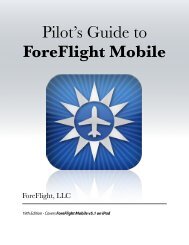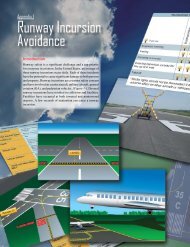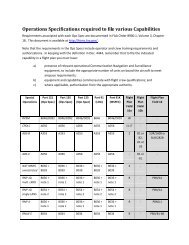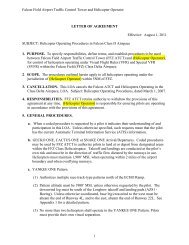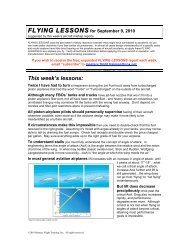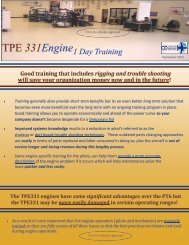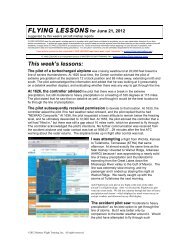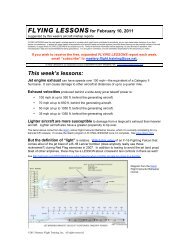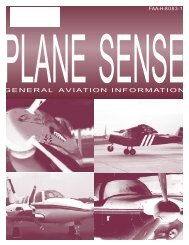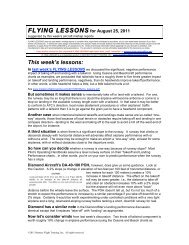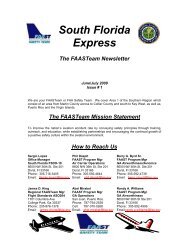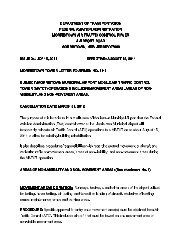WINGS Pilot Proficiency Program User's Guide - FAASafety.gov
WINGS Pilot Proficiency Program User's Guide - FAASafety.gov
WINGS Pilot Proficiency Program User's Guide - FAASafety.gov
You also want an ePaper? Increase the reach of your titles
YUMPU automatically turns print PDFs into web optimized ePapers that Google loves.
1. Overview<br />
1.1.<br />
Objective<br />
The objective of the <strong>WINGS</strong> program, especially at the Basic Level, is to address the<br />
primary accident causal factors that continue to plague the general aviation community,<br />
and in such a manner as to suggest mitigation strategies to avoid those accidents.<br />
The <strong>WINGS</strong> <strong>Pilot</strong> <strong>Proficiency</strong> <strong>Program</strong> is based on the premise that pilots who maintain<br />
currency and proficiency in the basics of flight will enjoy a safer and more stress-free<br />
flying experience. Requirements for each aircraft category and class include specific<br />
subjects and flight maneuvers. The <strong>WINGS</strong> <strong>Program</strong> consists of learning activities and<br />
flight tasks selected to address the documented causal factors of aircraft accidents.<br />
You select the category and class of aircraft in which you wish to receive training and in<br />
which you wish to demonstrate your flight proficiency to applicable standards. To ensure<br />
you receive a well-rounded learning experience, only certain activities fulfill specific<br />
credit requirements. See Section 7 for more information on this topic.<br />
1.2.<br />
Who Can Participate<br />
All pilots holding a U.S. pilot certificate may participate in the <strong>WINGS</strong> <strong>Program</strong>. To<br />
participate in flight portions of the program, pilots should contact certificated flight<br />
instructors and flight schools, and other FAASTeam Members, who are or will participate<br />
in the <strong>WINGS</strong> <strong>Program</strong>.<br />
Student pilots are encouraged to participate in the <strong>WINGS</strong> <strong>Program</strong>. They will receive<br />
Phase 1 at the Basic Level upon satisfactory completion of their Private <strong>Pilot</strong> practical test<br />
and completion of an online course on Aeronautical Decision Making. Note that student<br />
pilots will initially register on <strong>FAASafety</strong>.<strong>gov</strong> as a non-airman.<br />
For additional information on the requirements, please follow this link:<br />
1.3.<br />
http://faasafety.<strong>gov</strong>/<strong>WINGS</strong>/pppinfo/requirementDetails.aspx<br />
<strong>WINGS</strong> Levels<br />
The <strong>WINGS</strong> <strong>Program</strong> was recently redesigned to simplify the process of attaining or<br />
demonstrating proficiency in just a few simple steps. There are three Levels available:<br />
<br />
<br />
Basic <strong>WINGS</strong>: This level is designed for those pilots who want to establish a<br />
recurrent training program that will provide them a higher level of proficiency<br />
than merely preparing for a normal Flight Review as required by 14 CFR 61.56.<br />
Note that pilots need not accomplish the flight review requirements of 14 CFR part<br />
61.56, if he or she has satisfactorily completed any Phase in the <strong>WINGS</strong> - <strong>Pilot</strong><br />
<strong>Proficiency</strong> <strong>Program</strong> since the beginning of the 24th calendar month before the<br />
month in which that pilot acts as pilot in command.<br />
Advanced <strong>WINGS</strong>: This level is designed for those pilots who want to design a<br />
program that will take them a step above the Basic Level. It affords the pilot an<br />
opportunity, in concert with his/her instructor, to tailor a portion of the training to<br />
fit more specific needs of the individual while maintaining the requirement to<br />
demonstrate proficiency.<br />
FAA Safety Team | Wings User’s <strong>Guide</strong> 1




